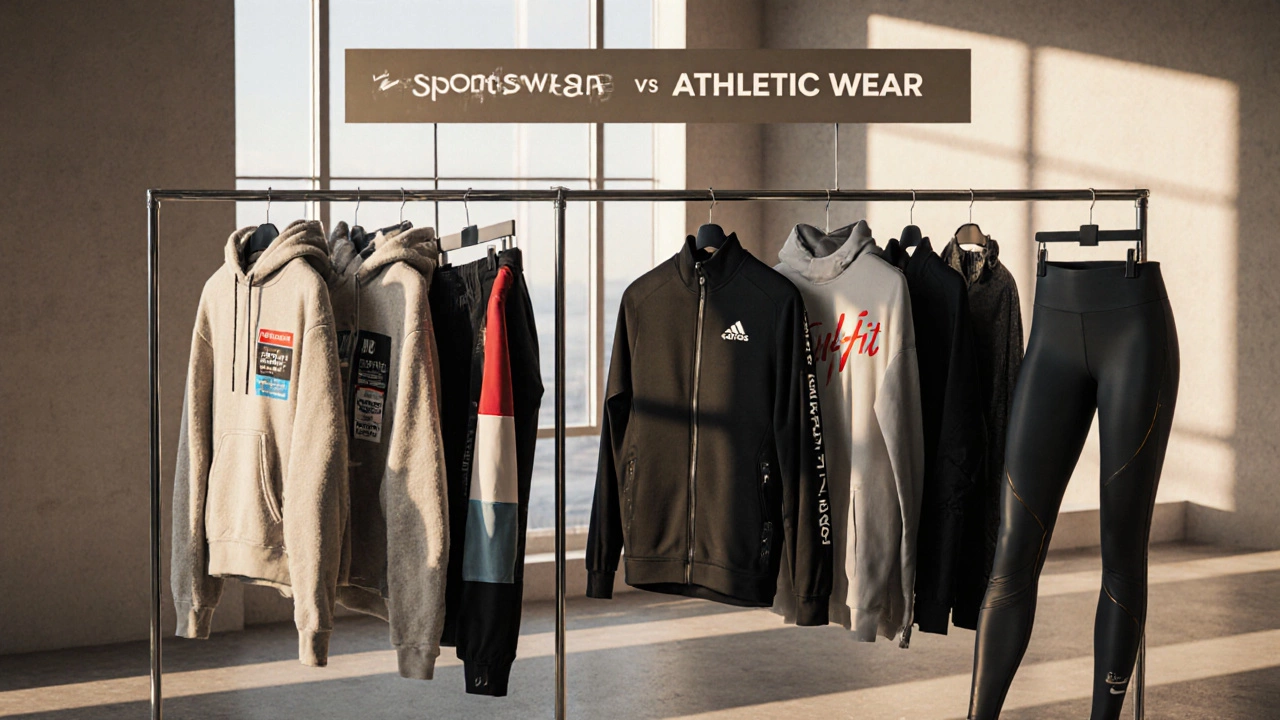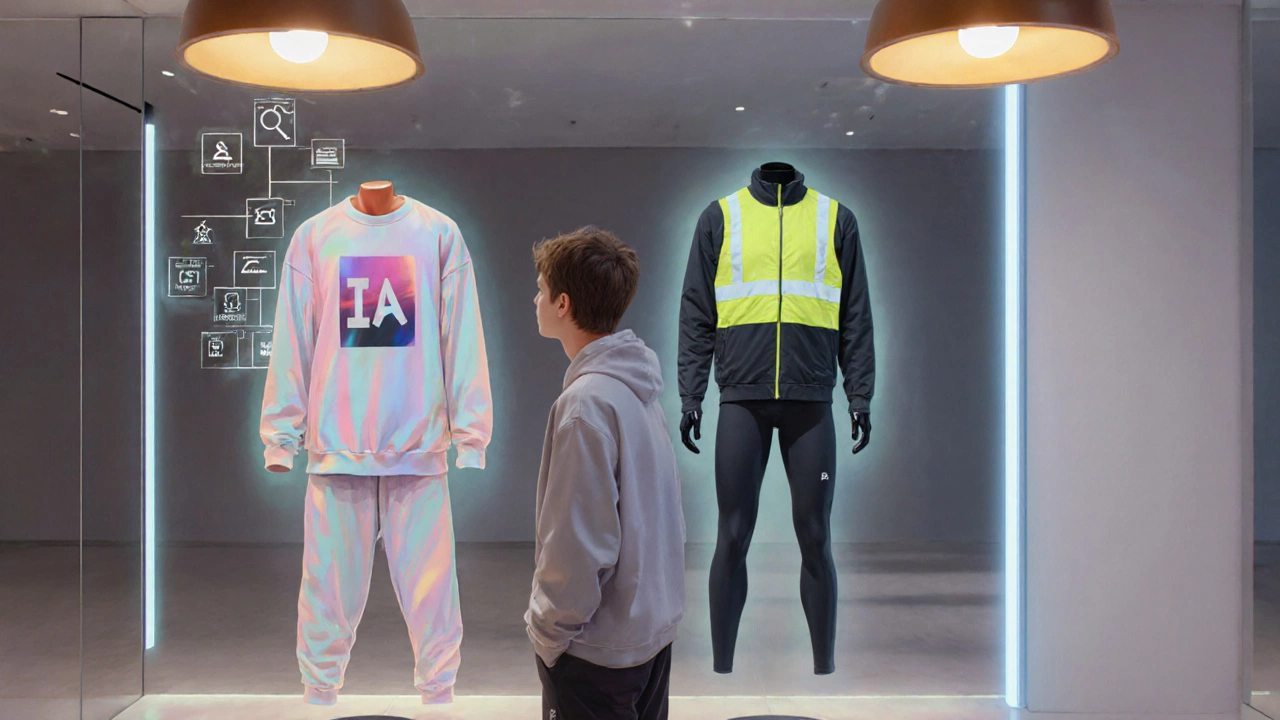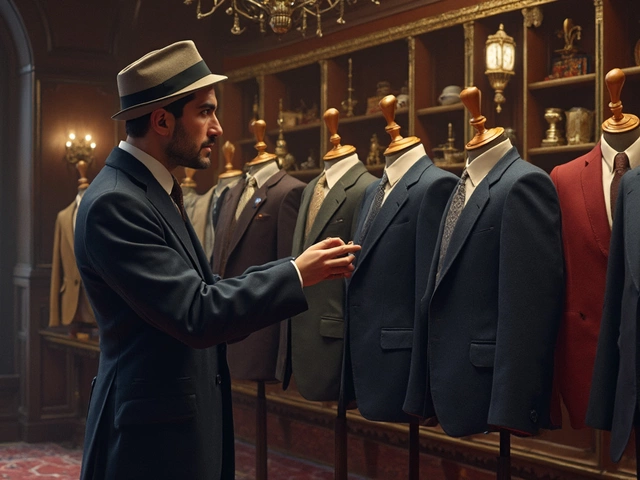Sportswear vs Athletic Wear: Key Differences Explained

- Cleo Fairchild
- 10 October 2025
- 0 Comments
Ever stare at a rack of joggers, a sleek track jacket, and wonder whether you’re looking at sportswear or athletic wear? The two terms get tossed around like they mean the same thing, but they actually point to different design goals, materials, and style cues. Knowing the distinction helps you pick the right piece for the gym, the office, or a weekend coffee run.
Key Takeaways
- Sportswear blends sporty aesthetics with everyday comfort; it’s more fashion‑forward.
- Athletic wear is engineered for performance, using technical fabrics that manage sweat, heat, and movement.
- Material choice-cotton blends vs. moisture‑wicking synthetics-is the biggest functional divider.
- Style focus: sportswear leans on trends, while athletic wear leans on function.
- When shopping, match the activity level you need with the garment’s primary purpose.
Below we break down each category, compare their core attributes, and give you practical tips for buying the right gear.
What is Sportswear?
Sportswear is clothing that takes inspiration from athletic design but is intended for casual, everyday wear. It emphasizes comfort, style, and versatility, often blending performance details with street‑ready silhouettes. Think of a pair of tapered joggers paired with a logo‑heavy hoodie-perfect for a brunch after a light jog or a relaxed office casual day.
Key characteristics:
- Relaxed fits that prioritize ease of movement without a compression feel.
- Materials range from soft cotton blends to modestly technical fabrics.
- Design cues include bold branding, color blocking, and trend‑forward details like tapered legs or cropped tops.
What is Athletic Wear?
Athletic wear is garments engineered for specific sports or high‑intensity workouts. These pieces use cutting‑edge textiles that regulate temperature, wick moisture, and support muscle groups during vigorous activity. A typical example is a compression legging made from nylon‑spandex blends designed for marathon training.
Core traits include:
- Technical fabrics such as polyester, nylon, elastane, and proprietary blends (e.g., Nike Dri‑Fit, Adidas Climalite).
- Built‑in features: flat seams, anti‑chafe panels, UV protection, and strategic ventilation.
- Fit levels that range from tight compression to supportive mid‑rise, all meant to enhance performance.
Functional Differences at a Glance
Both categories share a sporty vibe, but the purpose behind each piece diverges sharply.
- Primary Goal: Sportswear aims to look good off the field; athletic wear aims to improve on‑field performance.
- Activity Intensity: Sportswear handles low‑impact activities (light walks, errands). Athletic wear is built for high‑impact sessions (HIIT, cycling, competitive running).
- Durability vs. Flexibility: Sportswear favors longevity for everyday wear, while athletic wear favors stretch and quick‑dry recovery.

Material & Technology: The Fabric Factor
Materials are the single biggest differentiator. Below are the most common fabrics you’ll encounter.
| Fabric Type | Typical Use in Sportswear | Typical Use in Athletic Wear |
|---|---|---|
| Cotton blends | Soft tees, relaxed joggers | Rare; only in low‑sweat zones |
| Polyester | Lightweight jackets, basic tees | Core performance fabric; wicks moisture |
| Nylon | Wind‑breakers, stylish windcheaters | High durability, quick‑dry for training gear |
| Elastane (Spandex) | Stretch denim, casual leggings | Provides compression and full range of motion |
| Proprietary blends | Occasional tech accents | Specialty tech (e.g., Dri‑Fit, Climalite, HeatGear) |
When you see a label that reads “100% polyester” on a hoodie, chances are you’re looking at sportswear. If the tag mentions “4‑way stretch” and “moisture‑wicking”, you’re in athletic wear territory.
Style Meets Function: When Does One Overlap?
The lines blur when fashion brands release “performance‑inspired” collections and sport brands drop runway‑ready pieces. This hybrid segment is often called “athleisure”. However, the distinction still matters when you need a garment for a specific purpose.
Consider a sleek black track jacket:
- If it has rubberized panels, zippered vents, and a Dri‑Fit label, it’s leaning athletic.
- If it’s made of soft French terry with a subtle logo, it’s leaning sportswear.
Buying Guide: How to Choose the Right Piece
Follow this quick decision tree before you add anything to your cart.
- Ask yourself the main activity: Is it high‑intensity training or casual daily wear?
- If high‑intensity, look for moisture‑wicking, compression, and targeted ventilation.
- If casual, prioritize comfort, style, and easy‑care fabrics.
- Check the garment’s care label: sportswear usually tolerates regular machine cycles; athletic wear often recommends gentle wash to preserve technical finishes.
- Fit test: athletic wear should hug muscles without restricting movement; sportswear should feel relaxed but not baggy.

Comparison Table: Sportswear vs Athletic Wear
| Aspect | Sportswear | Athletic Wear |
|---|---|---|
| Primary purpose | Style‑forward, everyday comfort | Performance enhancement during sport |
| Typical materials | Cotton blends, soft polyester, French terry | Technical polyester, nylon, elastane blends |
| Fit | Relaxed to semi‑relaxed | Compression to supportive fit |
| Key features | Brand logos, color blocking, trend cues | Moisture‑wicking, breathability, UV protection |
| Best for | Running errands, casual meet‑ups, light workouts | Intense training, competitions, outdoor extremes |
Seeing the table side‑by‑side makes the decision a lot clearer-especially when you’re browsing a brand’s seasonal catalog.
Common Mistakes to Avoid
- Buying athletic wear for style alone. Technical fabrics can feel too tight or “industrial” if you only need a casual look.
- Choosing sportswear for high‑intensity sessions. Cotton blends trap sweat, leading to chafing and discomfort.
- Ignoring care instructions. Washing performance pieces with harsh detergents degrades fabric properties.
- Over‑paying for branding. A logo‑heavy sportswear hoodie can cost twice as much as a plain but equally comfortable alternative.
Brands That Nail the Distinction
While many brands blur the lines, a few stand out for sticking to one side.
- Nike - Athletic wear powerhouse: Dri‑Fit tees, ProCombat leggings.
- Adidas - Balanced: Technical sportswear (Climalite) and fashion‑first Originals line.
- Lululemon - Athletic wear with a strong lifestyle spin; their Align leggings blend performance with softness.
- Champion - Sportswear specialist: plush hoodies, retro joggers.
Knowing where a label sits on the spectrum helps you shop with confidence.
Frequently Asked Questions
Can I wear athletic wear as everyday clothing?
Yes, many people love the sleek look of athletic pieces. Just pick items with a more relaxed cut (like joggers or a loose‑fit tee) and avoid the ultra‑tight compression gear unless you enjoy that aesthetic.
Is sportswear always made of cotton?
Not always, but cotton and cotton‑blends dominate because they feel soft and breathable for casual wear. Some sportswear lines now incorporate light technical fibers to add stretch or moisture‑wicking without losing comfort.
What’s the difference between athleisure and sportswear?
Athleisure is a hybrid term that blends the performance edge of athletic wear with the fashion focus of sportswear. It often uses high‑tech fabrics but is styled for street wear. Sportswear sits more firmly on the casual side, while athletic wear stays performance‑first.
Do I need to wash athletic wear separately?
It’s best to wash performance pieces on a gentle cycle with cold water and avoid fabric softeners. This preserves the moisture‑wicking and anti‑odor treatments. You can wash them with similar synthetics, but keep them away from heavy cotton items that produce lint.
Which is more expensive, sportswear or athletic wear?
Pricing varies by brand, but on average athletic wear tends to be pricier because of specialized fabrics and engineering. High‑end sportswear from fashion houses can match those prices, though, especially when branding and limited editions are involved.
By understanding the core differences-purpose, material, fit, and style-you can confidently pick clothing that matches your day’s agenda, whether that’s a casual coffee meetup or a grueling spin class. The next time you shop, ask yourself: sportswear vs athletic wear-which side of the spectrum serves my need?


